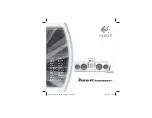
Frequency response
The graphs below show the frequency response of the PCS.
The upper graph shows the (normal) on-axis response and
illustrates the very high degree of accuracy; no frequency is
under or over emphasized more than 2 dB.
The second graph shows the on-axis, octave-averaged
response. This curve is representative of the speaker’s tonal
balance and shows that the PCS is very accurately balanced; any
over or under emphasis above 90 Hz is less than 0.5 dB.
The third graph shows the 30
°
off-axis, octave averaged
response and illustrates that the speaker’s overall energy
response is well balanced, with no large depressions in any area
of the spectrum. It is also noticable that this response remains
stronger in the 1 KHz to 3 KHz region than can be achieved with
2-way designs. This high degree of uniformity is in part the result
of the PCS’s first order crossover system.
The PCS uses a coaxial tweeter/midrange driver in order to
greatly reduce changes in response caused by different listener
heights. The coaxial driver configuration ensures that energy
from these drivers always arrives at the listener’s ears at the same
instant, regardless of the position of the speaker or the listener.
As can be seen on the following graphs, changes in the high
frequency response, where the greatest variation would normally
occur, are very small. Also, variations in the mid frequency
response are only moderate, even with rather large 10
°
changes
in the listening axis. 10
°
represents a height change of about 22
inches at a distance of 10 feet, covering listening heights (with a
32" stand) of 20 to 64 inches, equivelent to sitting on the floor to
standing.
Step response
This graph below shows the PCS’s response to a step signal.
Notice that the overall triangular shape is very well preserved
with the output remaining smoothly positive until 2.6 ms when it
finally crosses zero due to the fact that the bass response extends
to 55 Hz rather than DC. The irregularities seen in the first few
hundred microseconds are due to the tweeter diaphragm
resonance at the ultrasonic frequency of about 23 KHz.
Waveform accuracy this good can only be achieved with first
order crossovers and time coherent driver positioning.
Time response
The energy-time response of the PCS shows that the
speaker’s output quickly decays to -40 dB in 1.6 milliseconds,
indicating very clean inter-transient silence. Such performance is
the result of metal diaphragms that have no resonances within
their operating frequency range and very strong cabinet
construction using a 2" thick baffle, 1" thick cabinet walls and
internal bracing.
10K
Frequency
1K
25
20
15
10
5
0
-5
-10
100
20
20K
Amplitude — dB
On-axis, octave averaged, 30
°
octave averaged
Time – msec
0.5
1.0
Output
1.5
2.0
2.5
Time – msec
0.5
5
0
-5
-10
-15
-20
-25
-30
-35
1.0
Output — dB
1.5
2.0
2.5
Compound driver
The most unusual technical feature of the PCS is its use of a
compound driver where the tweeter dome and the midrange cone
are both driven by a single voice coil. The design is implemented
with a mechanical crossover – a “coupling” suspension between
the coil and the midrange cone. The stiffness of the coupling
suspension is sufficient so that at low frequencies the voice coil
moves both the tweeter dome and the mid cone in unison.
However, at high frequencies the coupling suspension’s
compliance is sufficient to “decouple” the mass of the mid
diaphragm from the movement of the coil and dome.
The advantages of this unique driver are that perfectly time-
coherent performance is achieved without the cost and
complexity of two magnet structures or an electrical crossover
network for the mid-to-tweeter transition. By optimizing the
compliance and damping of the coupling suspension and the
ratios of area and mass of the two diaphragms, the driver
exhibits extremely uniform response from 100 Hz to 20 KHz.
10K
Frequency
1K
25
20
15
10
5
0
-5
100
20
20K
Amplitude — dB
PCS octave-averaged
on-axis 10
°
up 10
°
down
Our goal for the PCS was to develop a compact speaker
system that did not compromise sonic quality. Accepting that the
small size would limit low frequency extension, it was decided
that no other significant limitation on performance would be
made and that every engineering technique used in our larger
speakers would be applied to this design.
Motivation for the design was to take advantage of our
(then) newly developed mechanical crossover coaxial midrange/
tweeter to achieve 3-way performance in a compact speaker.
Since virtually all speakers in this size category are 2-way
designs, this new driver would allow superior performance for
this type of system. Since the woofer would be small,
performance could be achieved equivalent to a large 4-way
system, except for the deep bass. (This is analogous to small 2-
way systems achieving performance equivalent to a large 3-way,
except for the deep bass.)
Further motivation was the realization that this performance
level could be achieved at a relatively reasonable price since the
new coaxial driver was more cost-effective than separate mid
and tweeter drivers of similar performance. In addition, the
elimination of the costs of an electrical mid/tweeter crossover
would also contribute to a very good performance/cost ratio.






















